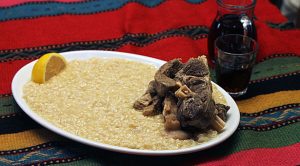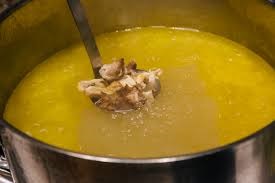
I have a confession to make. There are some Cretan recipes that make me weep. Especially if they are executed with love. As our climate is temperate and our herbs are abundant almost year round this makes for the perfect marriage between the right humble ingredients and full flavours. Spring and summer and maybe the first few days of autumn are known to all of us as the ‘invitation’ season. A couple will be married or a child will be christened and that can only mean one thing especially in the prefecture of Chania: pilaf. We call it pilafi=πιλάφι (risotto) and it is reason for me to cancel all my appointments just to be sure after I have wished the best to the couple or the child and wait patiently at the table till I see the steamy large bowls full to the brim with the tastiest rice one can ever have. Please feel free to call me an exaggerator but I will stick to my statement. And those who know will tell you I’m not lying. I’ve driven miles or even rented a room prior to the happy event if I know that not only the happy couple deserve our cheer but I deserve that god sent dish made from the hands of men and women who put so much love and care to give us this blessed dish.

But I need to take you a few months or even a year or two back before the happy celebration for you to understand the process of this rice godliness. When a couple decides to marry or christen their child a whole process begins to unravel and a slew of things need to be organised. One of these things is the lamb and the chicken that will be raised and fed with the best the land can offer in order for us to enjoy their meat on the day of the celebration. Literally a hunt begins to find the best shepherd if the family does not own the animals themselves. The animals are given the best possible feeding fields, free to roam and have the best possible life before they are sacrificed a couple of days before the event. The sheep that have grazed on herbs can be tasted in their meat and the chicken are plump and heavy from free grazing. The meat of a well grazed chicken is primarily more reddish or with yellow undertones, a sign it has not been in a commercial farm stuck in a cage with so many others like we see in most supermarkets.

So these animals and their feed found in nature are the first two things that make up the process of the pilafi getting to our plate. This means nothing however without a master cook who has spent hours understanding the science of an open wood fire, the enormous cauldron he will place the animal pieces in and slowly boil them for many hours until he sees the desired colour of the stock that will give us the final product. After the stock is ready the waiting begins. As the pilaf needs to come out at the right time when all are seated, the protagonists have made their appearance and speeches and the mains are ready to be served after the appetizers have been served. This waiting game must be nerve racking for the cook. These cooks are at the venue from the peak of dawn getting this particular dish ready as they know everyone is waiting for it. It is the protagonist of the menu after the celebrated couple or child. It can make or break a cook. I doubt I’d risk doing such a thing myself and feed so many people. It takes nerve and years of building up the confidence to serve something that looks so simple. But what I’ve come to realise is this: these cooks who get it right are doing it with love, care and a touch of pride. And that in my opinion is the element or ingredient that cannot be bought.

Cretan celebratory tables are laid out with so many delicacies that need their own article and so many of them are openly welcomed to be consumed but you can always bet everyone will say ‘I wonder if the pilafi is going to be good’. And when it comes we all instinctively look at each other to see who is going to get the first spoonful of the hot rich in flavour rice we all have come to love. We love our toppings of pepper, lemon and yoghurt that can go with it but my first round is always neat, just as it comes so I can taste the herbs in the meat stock, and after a few mouth full’s we all begin to ooh and ahh giving smiles of approval while hoping a fresh second round will come and eat till we are bursting to the seams. Very little talking happens around this time except to say how good it is. I usually and unapologetically have three platefuls. Afterward I sit back in my chair happily, in a semi comma, dreaming of then next invite that will put me in this place of nirvana while nursing a full belly.
It’s hard to find this dish in a tavern. And when the odd grandfather-grandmother remote little tavern tells you they have it on the menu I ask them to repeat themselves in case I misjudged my hearing. Upon confirmation I want o kiss the hands of these people as I know I’m in for an unexpected feed from the heavens.
How this dish came to be is easy to imagine as our shepherds only had a few ingredients all these years in the remote villages and mountains and by default they only sacrificed an animal for special occasions. So passing down the wisdom of this dish is essentially a matter of repetition till the recipe becomes perfected and adding love that goes into every mouthful. I hope you get an opportunity to taste this plateful of nirvana one day. I promise you it will be memorable…
The Terra Creta explorer
